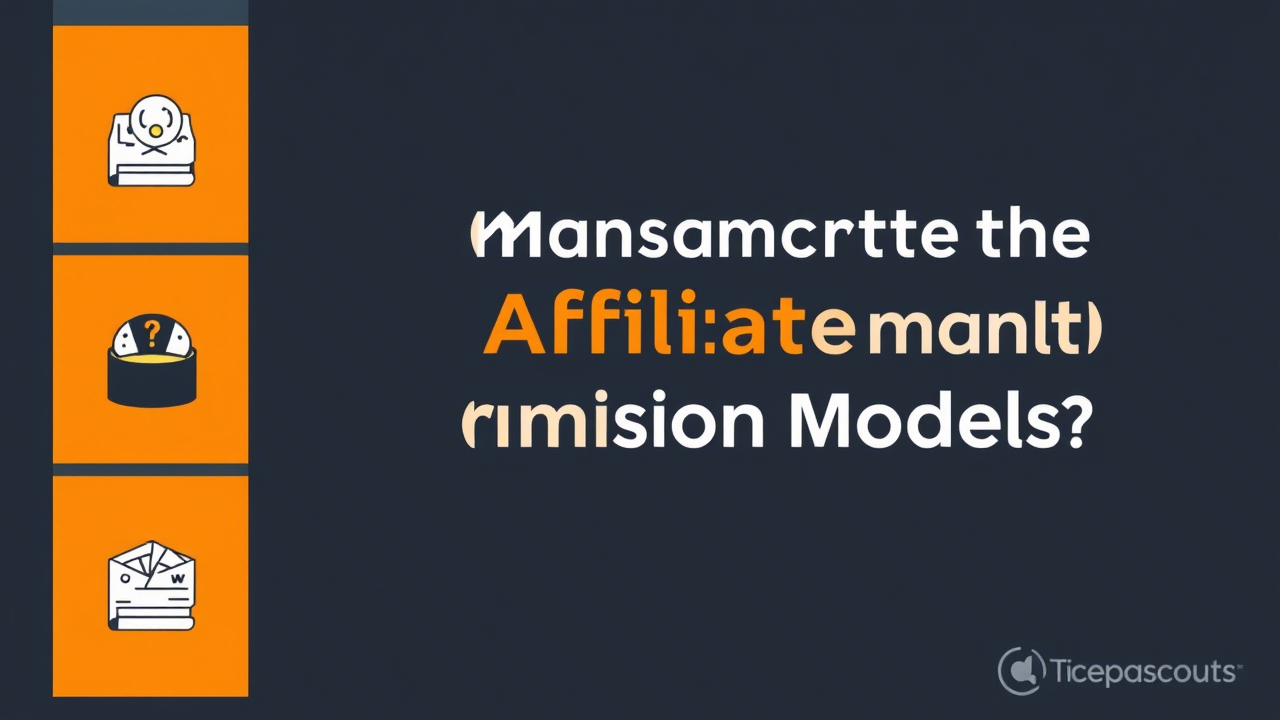Affiliate marketing has transformed the way people earn money online. Selling products or services allows affiliate marketers to earn commissions on sales, leads, or other actions driven through their referral links, which translates to more money in the bank.
This model of business has generated plenty of interesting sales and partnership opportunities that make it a smart decision for content creators and marketers of all industries.
The issue is, there are several various affiliate commission models that can influence whom you would prefer to work with. The various models determine the way and timing with which you are paid, so it is not surprising that choosing the appropriate model for your needs and long-term goals is paramount.
Today, we are going to learn about 7 of the most common affiliate commission models you should know about. Our goal is to tell you how each works and the pros and cons you should know before making a decision on what is best for you.
Besides, we’ll provide actionable advice to assist you in selecting the optimal model for your needs and effectively implement it into your marketing plan.
| Affiliate Commission Model | Description |
|---|---|
| Pay Per Sale (PPS) | Commission gained by affiliates when they sell via their referral link, typically a percentage of sale value. A favorite but one that usually requires skill to turn visitors into customers. |
| Pay Per Lead (PPL) | Commission gained by affiliates for getting leads, i.e., sign-ups or filling in forms. Lesser to achieve compared to sales but pays lesser as well. |
| Pay Per Click (PPC) | Affiliates earn a commission every time a visitor clicks on their referral link, regardless of whether a sale or lead is generated. It’s easy to manage but offers lower earnings per click. |
| Recurring Commissions | Affiliates earn ongoing commissions as long as the referred customer continues to pay for a subscription service. It provides a steady income stream but requires time to build up earnings. |
| Tiered Commissions | Affiliates get higher commission rates as they produce more sales or leads. It’s motivating but hard at times to move up to higher levels, especially for new players. |
| Two-Tier Affiliate Programs | Affiliates earn on their own sales and on the sales of other affiliates they bring in. It’s diversification of income but requires effective recruiting and managing skills. |
| Flat-Rate Commissions | The affiliates get a flat commission for each sale or action regardless of the sale value. It’s simple and guaranteed but won’t motivate improved-priced offers. |
Pay Per Sale (PPS)
Pay Per Sale (PPS) is one of the most common commission schemes for affiliates. In PPS, an affiliate receives a commission every time they convince someone to buy a product or service using their personal referral link. In most cases, the percentage at which an affiliate receives money is a fraction of what customers spend.
Suppose the percentage of PPS is 10%. An order worth $100 would pay an affiliate $10.
Most affiliate marketers prefer this payment structure because they can boost their earnings as their audience grows. They earn more money when they sell; that’s how it works. We’ve found that the connection between marketing and earning can be greatly motivating.
But it also takes some skill and effort to convert visitors into paying clients, so this can be tougher for new affiliate marketers who don’t yet have an established audience.
Another drawback to remember is conversion rates can be pretty low because it’s easier to get someone to do something like read a blog post or sign up for an email list than it is to get them to pull out their credit card and spend cash.
Despite these issues, PPS is among the most profitable ways of making money as an affiliate marketer.
If you are thinking of trying this model out yourself, you’re in your luck. We found that virtually 80% of internet businesses have some form of an affiliate program, which means there are plenty of options for you to choose from, whether your interest be anything from art to zoology.
Pay Per Lead (PPL)
In Pay-per-lead (PPL), affiliates are paid based on the generation of leads, not sales.
Quite literally, you get paid when a referred visitor takes a specific action on one of your affiliate sites, such as subscribing to a newsletter, filling out a form, or signing up for a free trial. It’s a favorite among industries with long sales cycles because it’s focused on capturing interest and potential buyers instead of making an immediate sale.
One of the main advantages of a PPL model is that it’s generally easier to generate leads than sales. People don’t necessarily want to purchase something when they come across a site for the first time, but they are generally more willing to sign up for an email list.
Because the barrier to entry is lower, even beginners can start earning money without having to master complex sales techniques right away.
There are a few drawbacks to consider, however. Because it’s usually easier to generate a lead than to sell, pay per lead is usually lower than with PPS. That is, you’ll have to accumulate a great number of leads so that you can build up momentum and make a significant amount of money.
There are certain disadvantages to point out, but the majority of companies consider the PPL model to be very effective and willingly pay for good leads, and therefore there’s a market for affiliates.
Credit card providers and insurance providers commonly utilize this model, with the advantage of buying potential buyers that can be converted into sales within a duration of time.
Pay Per Click (PPC)
The Pay-per-click (PPC) plan is yet another affiliate system under which affiliates may receive payment for every time a visitor clicks on an affiliate link. Unlike the initial two types of commissions that we have touched on up to now, the PPC program requires nothing from the visitor other than clicking the link to the partner site.
PPC is widely used because it’s convenient, low-maintenance, and, most of the time, effective. It’s a wonderful way for businesses to expand brand awareness, especially if they’re just establishing themselves in their industry.
Since you do not need to convince visitors to buy something or do something, you can start earning commissions immediately. This type of commission is particularly ideal for newbies who have not yet learned the techniques and expertise necessary to create leads or make sales.
But then again, the PPC model is not without disadvantages either. Commission per click tends to be extremely low, even lower than PPC, so you would need an even larger number of clicks in order to generate decent income. There is also the risk of attracting low quality traffic that never gets converted into leads or sales for the advertiser, which could adversely affect the sustainability and long term success of your affiliate relationships.
Google AdSense is the most well-known version of PPC. This program allows affiliates to monetize traffic simply by adding ad units to their web pages. In our experience, this is particularly lucrative for sites that get a lot of traffic and engagement.
Ultimately, PPC might not offer the highest payouts, but it’s still an attractive option for many affiliates because of its accessibility and availability.
Recurring Commissions
The Recurring Commissions program is one of the best ways to earn consistent income. As the name indicates, recurring means that affiliates earn money as long as the customer keeps using and paying for a service.
The best benefit is also connected to the name; unlike one-time payments, recurring commissions enable you to earn money from the same customer over and over again.
You will discover that this model is used mainly with repeat products like software services (SaaS), membership websites, and other repeat payment services.
SaaS products are of special interest because they will pay commissions between 20% and 70%. This means that for each time a customer pays their subscription fee, you could earn 20 to 70% of what a license would be!
The high earning power, coupled with regular payments, has the potential to transform each customer into a long-term revenue source.
But building a good income with this model takes time. At first, your income will be low because it takes time to convince people to subscribe to a new product. You should market quality services that you use and believe in because people can feel this authenticity and will be more likely to stay.
Recurring commissions can be extremely profitable if you’re willing to wait and focus on building long-term relationships with your viewers.
Tiered Commissions
There is a tiered commission system in place to reward affiliates for their success. Simply stated, your payout will increase based on how many sales or leads you produce.
This is how it works: Let’s say you’re selling a meal delivery subscription box. At the start, you get 10% on each sold box. When you sell 50 boxes, you get 15%; then, after selling 200, you get 25%.
The rates and structure will vary depending on your affiliates, but in general, it’s an extremely compelling and uplifting value proposition for affiliate marketers. The potential to earn more if you work harder will be an incredible energizer.
But there are challenges to hurdle. In order to reach the higher levels of commission, you typically must make a large amount of sales or leads. This can be difficult, especially for new marketers who don’t yet have a large client base or are selling in a saturated marketplace.
You will stand the best chance of success with such a commission plan if you are determined, patient, and well-versed in the service that you want to promote because the more you sell, the higher your earning potential will be.




